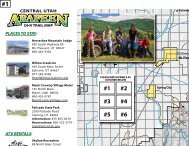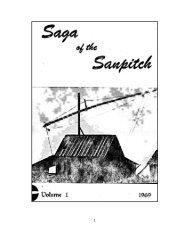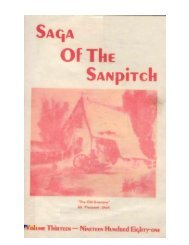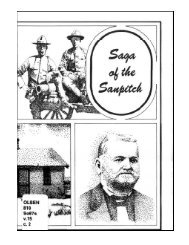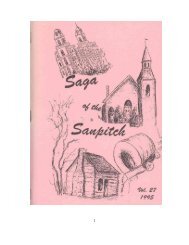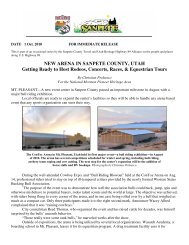Saga of the Sanpitch Volume 17, 1985 - Sanpete County
Saga of the Sanpitch Volume 17, 1985 - Sanpete County
Saga of the Sanpitch Volume 17, 1985 - Sanpete County
Create successful ePaper yourself
Turn your PDF publications into a flip-book with our unique Google optimized e-Paper software.
Paxman hung <strong>the</strong> huge east doors <strong>of</strong> <strong>the</strong> temple on a Monday. That night he suffered a terrible pain,<br />
explained Sister Hinckley. He died four days later <strong>of</strong> a strangulated hernia, "caused by his all out effort to get<br />
<strong>the</strong> doors in place."<br />
Sister Hinckley's mo<strong>the</strong>r was born eight months after Paxnian's death. Sister Paxman never remarried,<br />
remaining a widow for 62 years.<br />
"I love this holy temple," Sister Hinckley told <strong>the</strong> quiet congregation. Eyes <strong>of</strong> many glistened with tears<br />
as she told <strong>the</strong> faith-filled story <strong>of</strong> just one frontier craftsman who had sacrificed so much in helping to build<br />
this pioneer temple.<br />
Source: L.D.S. Church News, June 23, <strong>1985</strong>, p. 3.<br />
HENRY, THE PEG-LEG MAN<br />
Henry John was a pr<strong>of</strong>essional singer and harpist in <strong>the</strong> country <strong>of</strong> Wales. He played for royalty, playing<br />
and singing as only an expert could . He traveled from village to village and from city to city performing .<br />
Finally, with a wonderful woman who had a beautiful singing voice, <strong>the</strong>y entertained almost every night.<br />
One day, misfortune came to Henry, and he lost a leg in a crusher while working in <strong>the</strong> coal mines .<br />
After this, he was unable to continue his pr<strong>of</strong>ession. It was hard for him to get around on his peg-leg.<br />
In 1870 he heard <strong>the</strong> Mormon missionaries and joined <strong>the</strong>ir church. He came to Utah and finally to<br />
Wales in <strong>Sanpete</strong> <strong>County</strong>, where he found it hard for a harpist and a singer to find work. He was getting older,<br />
<strong>the</strong> language barrier was causing him problems, and with <strong>the</strong> handicap <strong>of</strong> his peg-leg finding a job was almost<br />
impossible.<br />
When a call came out from <strong>the</strong> leaders <strong>of</strong> <strong>the</strong> LDS Church that men were needed to work on <strong>the</strong> new<br />
project <strong>of</strong> building <strong>the</strong> Manti Temple, Henry went to Manti, Twelve days later one hundred men knelt in<br />
prayer at <strong>the</strong> site to ask for guidance and help in accomplishing this great work.<br />
Up temple hill he hobbled with his one peg-leg and his one good leg. Ropes were attached to posts to<br />
help Henry and o<strong>the</strong>rs needing help up <strong>the</strong> hill. Here he worked, sitting in <strong>the</strong> same position all day, chipping<br />
with his chisel <strong>the</strong> rock that had been quarried and hauled to <strong>the</strong> brow <strong>of</strong> <strong>the</strong> hill. Sometimes he pounded <strong>the</strong><br />
rock chips into fine sand to be used in mixing <strong>the</strong> mortar for cementing toge<strong>the</strong>r <strong>the</strong> huge blocks <strong>of</strong> oolite<br />
stone in <strong>the</strong> temple walls.<br />
The stonecutters and masons were <strong>of</strong> various ancestry. Some <strong>of</strong> <strong>the</strong> workers walked from Ephraim<br />
to Manti each Monday morning and returned home on Saturday night. Henry also traveled at times to Wales,<br />
Utah, when his week's work was done. Some workers stayed at <strong>the</strong> old Templeton Hotel, and o<strong>the</strong>rs used<br />
tents for <strong>the</strong>ir homes away from home.<br />
Sometimes <strong>the</strong> stakes were requested to furnish <strong>the</strong>ir workers with provisions and supplies, one<br />
month's rations at a time. While <strong>the</strong>se men were away from home, local people helped to sustain <strong>the</strong>ir<br />
families. The laborers worked an average <strong>of</strong> ten hours a day, six days a week.<br />
Henry's greatest asset was faith in God and a desire to do His will. Therefore, he steadfastly accepted<br />
his job at <strong>the</strong> temple and continued his work with a will that never faltered.<br />
He was always happy as he sat day in and day out for long periods <strong>of</strong> time chiseling rock for <strong>the</strong><br />
temple. Workers watched him with pride and with a little awe and confusion at how diligently he sat, patiently<br />
and without complaint, chiseling rock, watching <strong>the</strong> progress <strong>of</strong> <strong>the</strong> majestic edifice, as each rock he cut<br />
helped to take form in <strong>the</strong> massive structure.<br />
74



